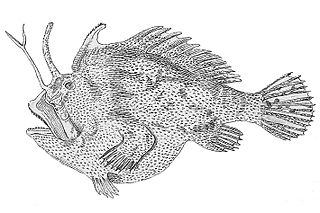
Frogfishes are any member of the anglerfish family Antennariidae, of the order Lophiiformes. Antennariids are known as anglerfish in Australia, where the term "frogfish" refers to members of the unrelated family Batrachoididae. Frogfishes are found in almost all tropical and subtropical oceans and seas around the world, the primary exception being the Mediterranean Sea.

The sargassum fish, anglerfish, or frog fish is a species of marine ray-finned fish belonging to the family Antennariidae, the frogfishes, the only species in the genus Histrio. It lives among Sargassum seaweed which floats in subtropical oceans. The scientific name comes from the Latin histrio meaning a stage player or actor and refers to the fish's feeding behaviour.

The spotfin frogfish, also known as the big-spot angler, coin-bearing frogfish, darkspot frogfish, ocellated angler, ocellated fringed fishing frog, opulent frogfish, spotfin angler or white-finger anglerfish, is a species ray-finned fish belonging to the family Antennariidae, the frogfishes. The spotfin frogfish is found in scattered locations the eastern Atlantic, Indian and western Pacific Oceans.

Commerson's frogfish or the giant frogfish, Antennarius commerson, is a species of euryhaline ray-finned fish belonging to the family Antennariidae, the frogfishes. This fish is found in the Indo-Pacific region.

Glauert's anglerfish is species of marine ray-finned fish belonging to the subfamily Histiophryninae in the family Antennariidae, the frogfishes. This species is the only species in the monospecific genus Allenichthys. This species is endemic to southern Australia.

Histiophryne is a genus of marine ray-finned fishes belonging to the subfamily Histiophryninae in the family Antennariidae, the frogfishes. These fishes are found in waters ranging from Taiwan to South Australia. There are currently five known species. These fishes are easily distinguished from other anglerfishes as having a reduced luring appendage, a highly evolved form of the first dorsal fin spine.

Antennarius is a genus of anglerfish belonging to the family Antennariidae, the frogfishes. The fishes in this genus are found in warmer parts of the Atlantic, Indian and Pacific Oceans.

Fowlerichthys is a genus of marine ray-finned fishes belonging to the family Antennariidae, the frogfishes. The fishes in this genus are found the Atlantic, Indian and Pacific Oceans.

Kuiterichthys is a genus of marine ray-finned fishes belonging to the subfamily Histiophryninae in the family Antennariidae, the frogfishes. These fishes are endemic to Australia.

Lophiocharon is a genus of marine ray-finned fishes belonging to the subfamily Histiophryninae in the family Antennariidae, the frogfishes. These fishes are found in the eastern Indian Ocean and Western Pacific Ocean.

Nudiantennarius is a monospecific genus of marine ray-finned fish belonging to the family Antennariidae, the frogfishes. The only species in the genus is Nudiantennarius subteres, the deepwater frogfish. This fish is found in the Western Pacific Ocean.

Phyllophryne is a monospecific genus of marine ray-finned fish belonging to the subfamily Histiophryninae in the family Antennariidae, the frogfishes. The only species in the genus is Phyllophryne scortea, the white-spotted anglerfish, smooth anglerfish or smooth frogfish, which is endemic to southern Australia.

Rhycherus is a genus of marine ray-finned fishes belonging to the subfamily Histiophryninae in the family Antennariidae, the frogfishes. The fishes in this genus are endemic to the waters off Australia. This genus is classified in the monogeneric family Rhycheridae, the Balrog frogfishes, by some authorities.

The painted frogfish, or spotted frogfish, black angler or painted anglerfish is a species of marine ray-finned fish belonging to the family Antennariidae, the frogfishes. This species is found in the Indo-Pacific region.
Porophryne is a monospecific genus of marine ray-finned fish belonging to the subfamily Histiophryninae in the family Antennariidae, the frogfishes. The only species in the genus is Porophryne erythrodactylus, the red-fingered anglerfish, red-footed frogfish, Bare Island anglerfish or Sydney anglerfish, which is endemism to the waters off New South Wales in eastern Australia. Both the species and the genus were first described in 2014.

Antennatus tuberosus, the tuberculate anglerfish, pygmy angler, pygmy frogfish or tuberculated frogfish, is a species of marine ray-finned fish belonging to the family Antennariidae, the frogfishes. This fish is found in the Indian and Pacific Oceans.

Echinophryne crassispina, the prickly anglerfish, prickly frogfish or thick-spined anglerfish, is a species of marine ray-finned fish belonging to the subfamily Histiophryninae in the family Antennariidae, the frogfishes. These fishes are endemic to the temperate waters of southern Australia.

Echinophryne mitchellii, the long-spined frogfish, bristly frogfish, Mitchell's anglerfish, Mitchell's frogfish, prickly angler fish or spinycoat anglerfish, is a species of marine ray-finned fish belonging to the subfamily Histiophryninae in the family Antennariidae, the frogfishes. These fishes are endemic to the temperate waters of southern Australia.

Lophiocharon trisignatus, the spot-tail anglerfish, rough anglerfish or three-spot frogfish, is a species of marine ray-finned fish belonging to the subfamily Histiophryninae in the family Antennariidae, the frogfishes. This fish is found in the Indo-Pacific region.

Histiophryninae, the star-fingered frogfishes, is a subfamily of marine ray-finned fishes belonging to the family Antennariidae, the frogfishes. The species in this family are found in the Indian and Western Pacific Oceans.



















